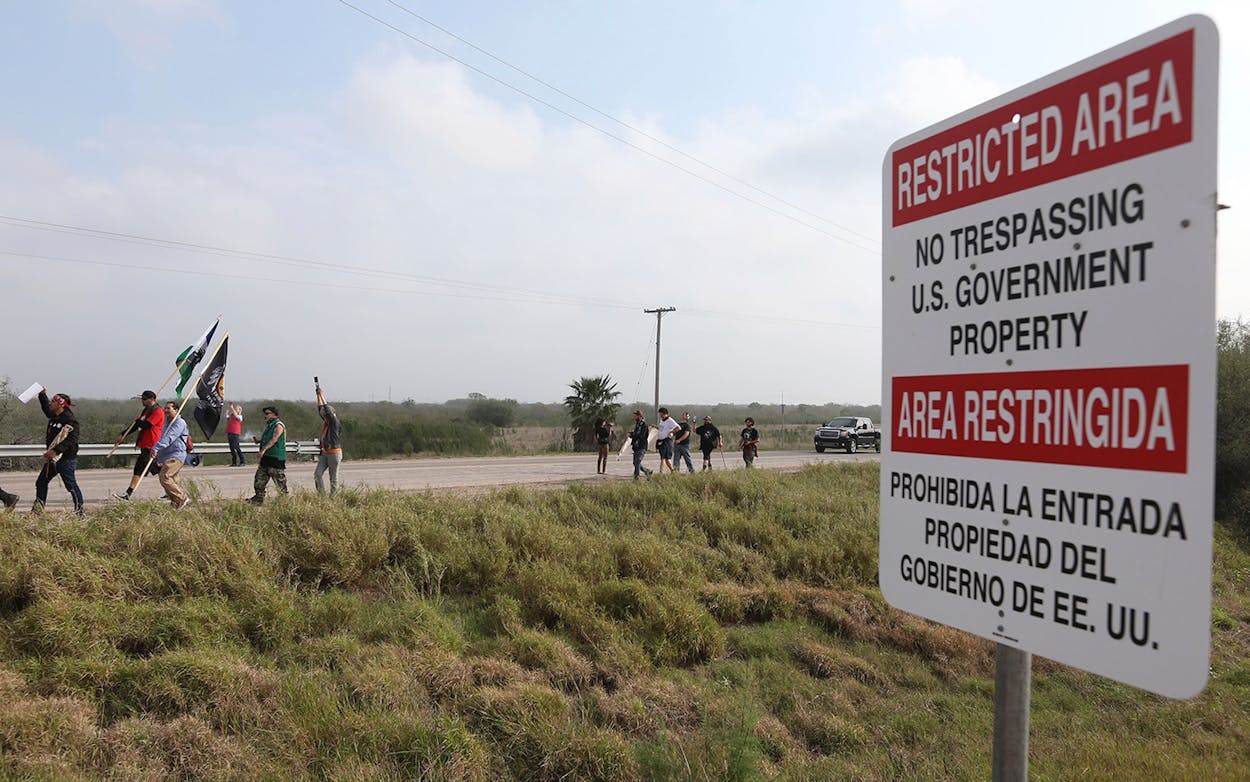With a federal funding fight over a border wall occupying much of the country’s consciousness—and expected to occupy much of President Trump’s State of the Union address Tuesday night—many people don’t realize that Congress already allotted nearly $1.6 billion for wall construction last year. That reminder grew into a grim reality for opponents of the wall this week as contractors are showing signs in South Texas of preparing to break ground for a new section of wall.
Thirty-three miles of wall construction in the Rio Grande Valley was appropriated by Congress in fiscal year 2018 when Republicans still controlled the House. Since then, large construction contracts have been let, and on Friday, U.S. Customs and Border Protection said that heavy machinery was headed for South Texas where a contract worth nearly $650 million has been awarded.
Equipment may have already arrived—a large, yellow excavator was spotted alongside the National Butterfly Center on Sunday in the border town of Mission. Most of the private, 100-acre butterfly refuge is expected to be cut off by the wall, and it’s not the only property where critics expect a wall to cause destruction. The wall is expected to bisect La Lomita Mission, a Catholic chapel that’s the namesake for the city of Mission, as well as Bentsen-Rio Grande Valley State Park and many private properties in the region.
“It’s one of the most insane, lunatic ideas floated in the history of this country,” Dr. Jeffrey Glassberg said of the border wall. Glassberg, a biologist and author, is president and founder of the North American Butterfly Association, which owns the private butterfly sanctuary in Mission. “I say that with the utmost conviction. It is lunacy. The only thing it would accomplish is destruction.”
Marianna Treviño-Wright, the center’s executive director, said the refuge will be unnecessary collateral damage from a national political debate. For years, U.S. Border Patrol vehicles have traversed the property searching for undocumented immigrants, but Treviño-Wright said the sanctuary is not a staging ground for human or drug trafficking. In fact, schoolchildren and nature enthusiasts from around the world visit the refuge annually, and there have been overnight camping events in the summer that the center has hosted, when visitors have gone out at night to hike and to search for owls.
The butterfly association has filed suit against the federal government in U.S. District Court in Washington, D.C., and Treviño-Wright testified before the U.S. House Committee on Natural Resources in January. She told the committee about unannounced visits from federal contractors on the butterfly center’s private property and about the laws waived by the federal government in order to make the wall a reality. The organization has also begun a GoFundMe account to raise money to fight the effort.
“They will likely begin destroying habitat in the El Morillo Banco tract of the Lower Rio Grande Valley National Wildlife Refuge, which is sandwiched between the National Butterfly Center and Bentsen-Rio Grande Valley State Park – Texas Parks and Wildlife,” Scott Nicol, co-chairman of the Sierra Club Borderlands Campaign, posted on Facebook. “When they are finished they will have less than half a mile of levee-border wall, just enough to take photos to send to Trump.”
Nicol is particularly critical of the actions of the city of Mission’s representative in Congress, who he said didn’t help the region’s long-term prospects last year. U.S. Representative Henry Cuellar, D-Laredo, whose district extends along the Rio Grande from Laredo to Mission, voted in favor of the 2018 spending bill that appropriated $1.571 billion for 33 miles of wall in South Texas. Cuellar’s Rio Grande Valley colleagues, U.S. representatives Filemon Vela, D-Brownsville, and Vicente Gonzalez, D-McAllen, voted against the bill.
Cuellar now sits in a position of influence, being the only border member of the Homeland Security Conference Committee, which is currently trying to strike a deal with the president that would avoid another government shutdown—a prospect Trump said has a less than 50-50 chance.
“I stand against the construction of any barrier that encroaches upon environmentally sensitive and cultural areas,” Cuellar said in a written statement released Monday. “In the fiscal year 2019 Democratic border security proposal, I included language prohibiting the use of funds towards physical barriers in protected areas along the border including the National Butterfly Center, Santa Ana Wildlife Refuge, Bentsen-Rio Grande Valley State Park, La Lomita Historical Park, and Lower Rio Grande Valley National Wildlife Refuge (SpaceX). Unfortunately, funding for these locations were packaged with a number of other critical needs including immigration judge teams, law enforcement canines, unmanned aerial systems, fixed and mobile video surveillance systems, ground sensors, and more. Our main task now, and moving forward, is to remove funding for a border wall appropriated in prior years and focus on prohibiting funding in the future.”
The butterfly association’s legal challenge, however, remains unresolved, and the case’s future might be bleak. When President George W. Bush tried to build a border wall in South Texas in 2008, scores of lawsuits were filed. There are still more than 60 cases pending from that time, according to Ricky Garza, a lawyer with the Texas Civil Rights Project, who is representing several landowners.
Glassberg knows this history, and he has recognized that his organization’s lawsuit will probably face a similar unfound conclusion, if not worse. “I have no expectation that we’ll prevail,” Glassberg said. “But we’re going to keep trying. What else can we do?”
- More About:
- Politics & Policy
- Border Wall
- Donald Trump
- Mission






